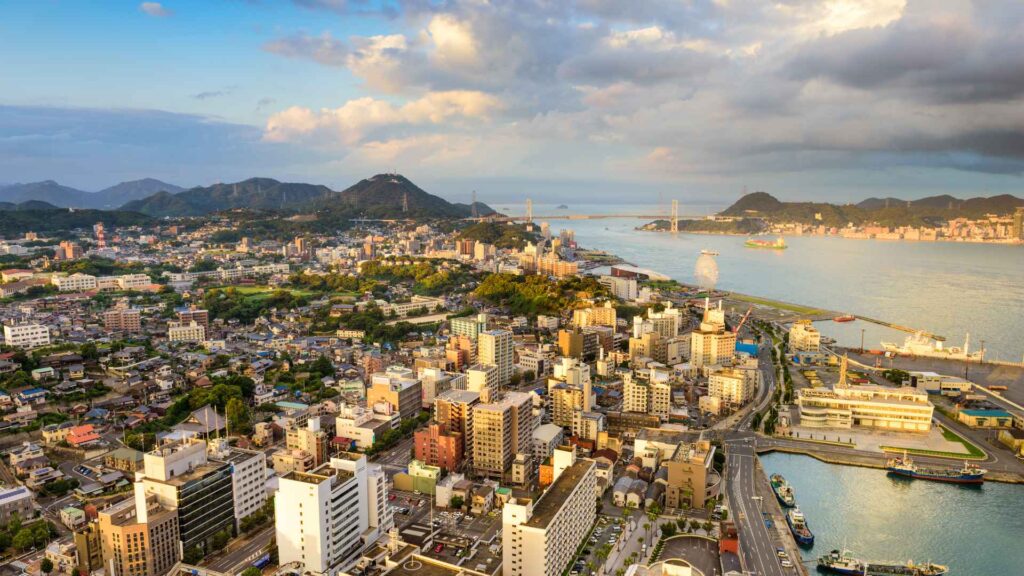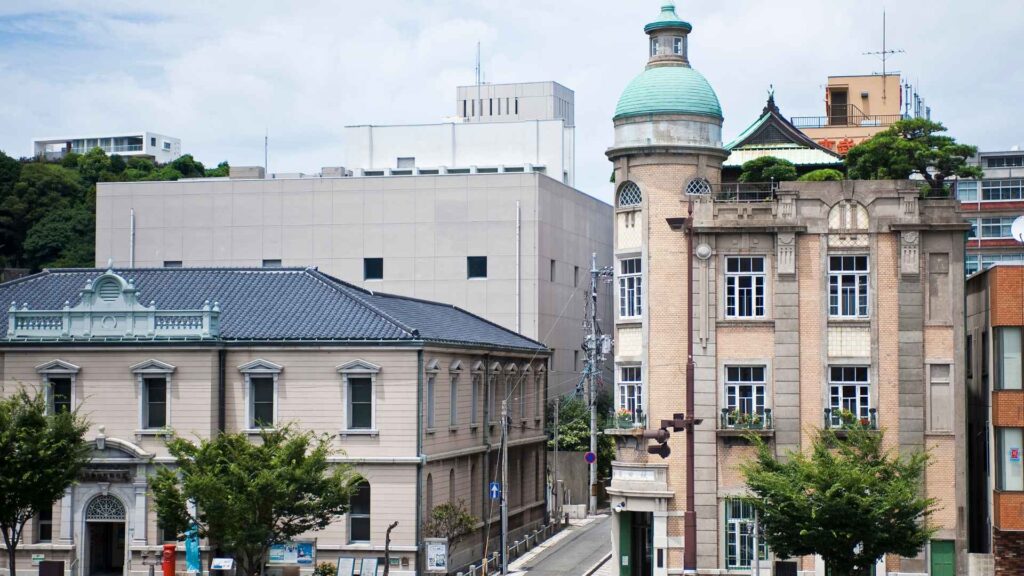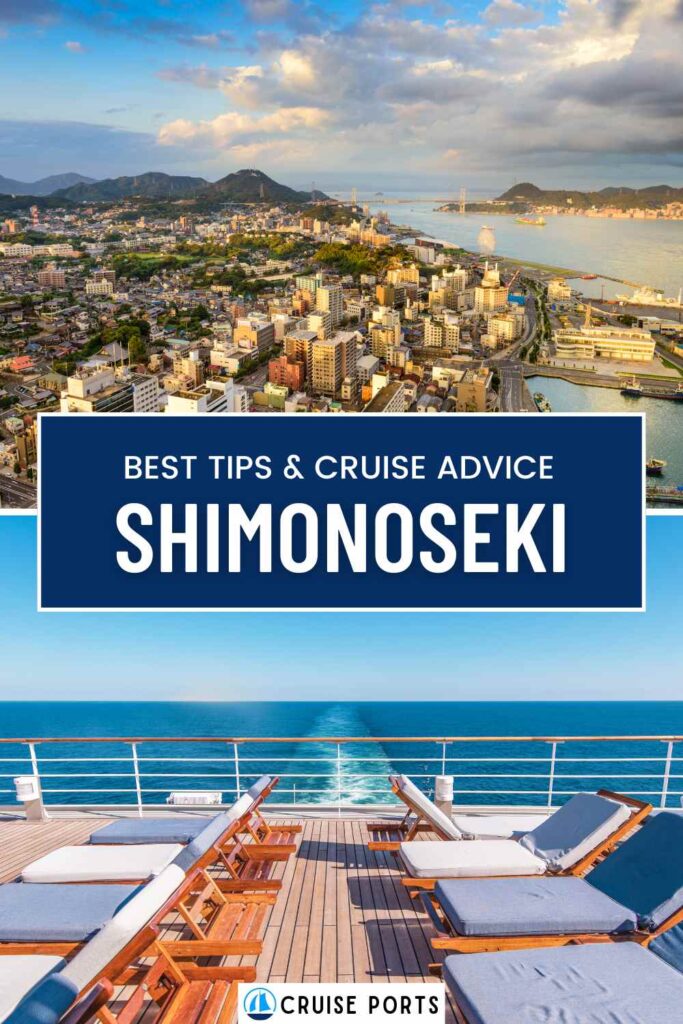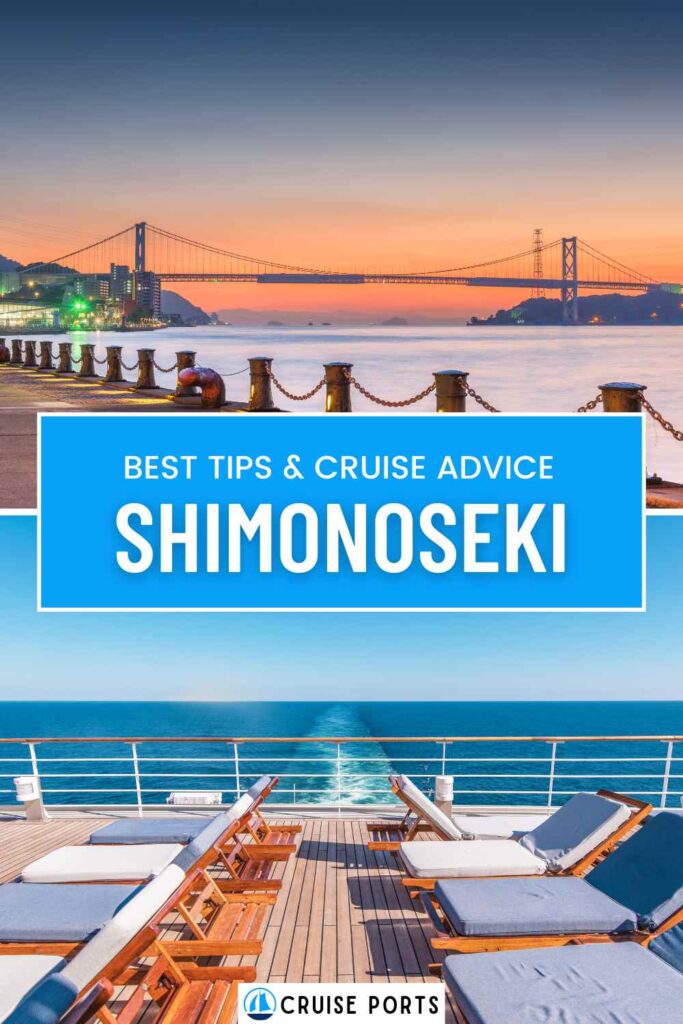Welcome to Shimonoseki, a coastal gem in Japan’s Yamaguchi Prefecture.
This bustling port town seamlessly blends maritime tradition, fresh seafood, and fascinating history.
In this ultimate guide, we’ll explore the best ways to experience Shimonoseki Cruise Port, from transportation tips to hidden cultural treasures—ensuring you make the most of your visit.
Understanding Shimonoseki Cruise Port
Situated at the southwestern tip of Japan’s main island, Honshu, Shimonoseki Cruise Port is a gateway to both ancient tradition and modern convenience.
The port faces the Kanmon Strait, a narrow body of water separating Honshu from Kyushu, making Shimonoseki a crucial maritime hub.
Here, centuries of fishing heritage blend with contemporary cruise terminal facilities that cater to travelers from around the world.

Location and Significance
- Strategic Hub: Shimonoseki sits at the crossing of two islands, allowing easy access to Kyushu and other parts of Honshu.
- Historic Roots: The area has been a center of trade for generations, dating back to when fishing boats would ply these waters for fugu, the famous pufferfish delicacy.
Port Facilities
The Shimonoseki Cruise Port Terminal features modern amenities designed with the comfort of travelers in mind.
You’ll find helpful signboards in Japanese and English, currency exchange counters, and a tourist information desk ready to assist with local directions.
The terminal’s waiting areas are spacious, and its easy-to-navigate layout ensures that both experienced cruisers and first-time visitors can move through security and customs procedures swiftly.
Why Visit Shimonoseki
- Seafood Paradise: Known as Japan’s “Fugu Capital,” Shimonoseki is beloved for its seasonal catch.
- Cultural Fusion: Traditional shrines and modern coastal charms coexist, offering a balanced glimpse into local life.
- Convenient Excursions: From the port, you can explore Tsunoshima Island’s stunning bridge, the historical district of Chofu, or venture into nearby prefectures.
The city’s careful development of its port facilities has made Shimonoseki an increasingly popular stop for international cruise lines.
If you’re keen on blending the excitement of a vibrant maritime city with the comforts of an accessible cruise terminal, Shimonoseki Cruise Port will not disappoint.
Welcoming staff, straightforward signage, and a user-friendly environment create a seamless entry point into southern Japan’s hidden wonders.
Whether you’re docking for a day trip or planning a longer stay, understanding Shimonoseki’s unique location and port advantages is the first step toward a memorable adventure.

How to Get There
Getting to Shimonoseki Cruise Port is refreshingly straightforward. With excellent connectivity by rail, road, and air, visitors have a variety of options to suit their preferences and travel styles.
Whether you’re flying in, hopping on a bullet train, or driving through scenic coastal roads, arriving in Shimonoseki can be both convenient and visually stunning.
Flying to Nearby Airports
- Fukuoka Airport (FUK): Located in the neighboring prefecture of Fukuoka on Kyushu, this busy international airport is about a two-hour journey to Shimonoseki by train or bus.
- Yamaguchi Ube Airport (UBJ): A smaller regional airport, ideal if you’re already in Japan. From here, you can take local buses or rent a car for the hour-long drive to the port.
- Kitakyushu Airport (KKJ): Another option in Kyushu with domestic connections, it offers relatively easy access via the Kanmon Bridge.
Rail Connections
One of the most popular ways to travel around Japan is by train. Shimonoseki Station is served by JR West lines, including the Sanyo Main Line.
For speed enthusiasts, the Shin-Shimonoseki Station accommodates the Sanyo Shinkansen (bullet train), which can take you to major cities like Hiroshima or Osaka in just a few hours. Once you arrive at Shimonoseki Station, local buses or taxis can shuttle you straight to the cruise terminal.
- JR Pass Tips: If you’re traveling extensively in Japan, a Japan Rail Pass can save you money and simplify rail travel.
- Shuttle Buses: Some cruise operators or local travel agencies offer shuttle services directly from the station to the port.
Driving and Ferry Options
For travelers who enjoy road trips, renting a car can give you the freedom to explore surrounding attractions at your own pace. Major highways and scenic routes connect Shimonoseki with other parts of the country.
Notably, the Kanmon Bridge ties Shimonoseki to Kitakyushu in Kyushu, offering stunning views as you cross the strait.
Alternatively, an inter-island ferry can be a relaxing way to approach Shimonoseki. These ferries often serve other coastal areas, so you can experience multiple ports along the way.
Travel Tips
- Plan Ahead: Check train schedules or flight times to align with your cruise departure.
- Pack Light: If you’re transferring between modes of transport, having fewer bags makes for a smoother journey.
- Google Maps: Or local transit apps can help you navigate train times, bus routes, and more with ease.
Ultimately, the path you choose to Shimonoseki Cruise Port can be as varied as the city’s culinary offerings.
Whether you opt for the quick efficiency of bullet trains or the leisurely pace of a coastal ferry, rest assured that Shimonoseki’s well-connected travel network ensures a hassle-free start—or finish—to your cruise adventure.
Local Attractions and Excursions
Once you step off your cruise ship, a world of sightseeing, exploration, and gastronomic delights awaits.
Shimonoseki’s prime location along the Kanmon Strait means you’re never far from coastal vistas, historical sites, and modern entertainment.
Whether you’re looking to immerse yourself in local culture or simply enjoy scenic landscapes, the region offers an array of attractions suited to every traveler’s taste.
Must-See Landmarks
- Karato Market: This bustling fish market is a seafood lover’s paradise. Indulge in freshly prepared sushi, sashimi, and seasonal specialties.
- Akama Shrine: With a striking red entrance and serene waterfront views, this historic Shinto shrine honors Emperor Antoku and commemorates the Battle of Dan-no-ura.
- Kanmon Bridge: Linking Honshu and Kyushu, the majestic Kanmon Bridge makes for an iconic backdrop, especially when illuminated at night.
Nearby Highlights
- Tsunoshima Island: A leisurely drive from Shimonoseki, Tsunoshima’s famous bridge is one of Japan’s most picturesque coastal spots. Enjoy turquoise waters and white-sand beaches.
- Chofu Samurai District: Stroll through this well-preserved Edo-period area to admire samurai residences, quaint tea houses, and tranquil gardens.
- Kaikyokan Aquarium: Featuring an impressive range of marine life, including sharks and an extensive pufferfish exhibit, this aquarium is a family-friendly spot.
Group Tours vs. Independent Exploration
- Group Tours: Ideal for those who want to see multiple sites in a limited time. Guides provide cultural insights, handle transportation, and often include lunch stops.
- Independent Exploration: Shimonoseki is relatively easy to navigate by public transport or car. If you prefer flexible schedules and discovering hidden gems at your own pace, exploring independently might be perfect.
Excursion Tips
- Wear Comfortable Shoes: Many attractions, like Karato Market and Akama Shrine, involve walking.
- Check Operating Hours: Markets and aquariums may close earlier on certain days.
- Book Ahead: Popular tours or experiences, especially during peak seasons, can fill up quickly.
Shimonoseki’s attractions combine historical charm and modern flair, reflecting the city’s enduring spirit. You might start your morning perusing fish stalls at Karato Market, then spend the afternoon marveling at Edo-period architecture in Chofu.
Round out the day with a sunset walk along the Kanmon waterfront or dinner at a local izakaya. Every corner you turn reveals yet another facet of Shimonoseki’s diverse identity, ensuring your cruise stop becomes a highlight of your journey across Japan’s shores.

Cultural Experiences to Savor
Shimonoseki is steeped in tradition, offering opportunities for you to immerse yourself in local customs, savor unique flavors, and connect with a history that’s intimately tied to the sea.
From seasonal festivals celebrating maritime bounty to artisanal crafts that have been passed down through generations, the cultural scene here is as vibrant as it is varied.
Traditional Events and Festivals
- Strait Festival (Kaikyo Matsuri): Held annually along the Kanmon Strait, this festival features parades, music, and vibrant performances that pay homage to the city’s maritime heritage.
- Suo Kokubunji Temple Cherry Blossoms: During spring, cherry blossom trees around historic temples create a picturesque backdrop for hanami (flower viewing) parties.
- Local Matsuri: Smaller neighborhood festivals, often centered around shrines, showcase traditional dances, taiko drumming, and colorful mikoshi (portable shrines).
Culinary Delights
No visit to Shimonoseki would be complete without sampling fugu (pufferfish). Known for its delicate, slightly chewy texture, fugu is prepared by certified chefs who follow strict safety protocols.
Other local specialties include squid, sea urchin, and seasonal seafood that highlight the city’s connection to the sea.
- Fugu Sashimi: Thinly sliced and served with ponzu sauce, this dish reflects the pinnacle of fish artistry.
- Fugu Hot Pot (Tecchiri): A warming stew featuring succulent pufferfish chunks, tofu, and vegetables.
- Sake Pairings: Distilleries often suggest sake varieties that complement the subtle flavors of fugu and other seafood.
Meaningful Local Interactions
- Cooking Classes: Some local chefs offer short workshops on how to prepare regional dishes, providing hands-on insights into Shimonoseki’s food culture.
- Tea Ceremonies: Experience the meditative grace of a traditional Japanese tea ceremony at local cultural centers or temple gardens.
- Artisan Crafts: From handcrafted pottery to delicate paper-making techniques, you’ll find studios and shops where local artisans keep time-honored crafts alive.
Engaging with Shimonoseki’s culture is about more than ticking items off your travel list; it’s about embracing the intimate bond between the region’s past and present.
Whether you stand shoulder-to-shoulder with locals at a bustling festival or learn the art of preparing a perfectly balanced tecchiri, you’ll gain a deeper appreciation for the city’s soul.
Let the rhythms of drumbeats, the taste of fresh fugu, and the glow of lantern-lit temples reveal Shimonoseki as not just a cruise port, but a living tapestry of cultural authenticity.
Tips for Cruisers
Cruising into Shimonoseki offers an exciting opportunity to explore Japan’s southwestern coast without the usual travel hassles.
However, making the most of your port day or multi-day stop requires smart planning and a bit of insider know-how. From budgeting your time wisely to navigating local customs, these tips aim to ensure a smooth, unforgettable experience.
Timing Your Trip
- Peak Seasons: Spring (cherry blossom season) and autumn (fall foliage) are immensely popular. If you plan to visit during these times, expect bigger crowds and book tours or experiences well in advance.
- Off-Peak Benefits: Traveling in winter or early summer can mean fewer tourists, cheaper accommodation, and a more relaxed vibe.
Money Matters
- Currency: The local currency is the Japanese yen. While many places accept credit cards, it’s wise to carry some cash, especially at smaller shops or street stalls.
- ATMs: Look for ATMs in convenience stores, larger shopping centers, or near train stations, which often have English interfaces for international cards.
- Tipping: Japan generally does not have a tipping culture. Exceptional service is considered standard, so simply paying your bill is sufficient.
Cruise Etiquette and Local Customs
- Punctuality: If you have a shore excursion planned or a return boarding time, be punctual. Cruises wait for no one.
- Respectful Behavior: When visiting shrines or temples, observe silence or low volume. Remove your shoes where indicated.
- Language Tips: Although many service providers speak basic English, learning simple Japanese phrases like “arigato” (thank you) or “sumimasen” (excuse me) can go a long way in building friendly interactions.
Packing Essentials
- Comfortable Footwear: Shimonoseki’s hilly terrain and winding roads call for sturdy walking shoes.
- Weather-Appropriate Attire: The coastal climate can shift quickly. Layer up or bring rain gear if traveling during wetter months.
- Portable Wi-Fi or SIM Card: Staying connected makes it easier to navigate, look up train schedules, or contact your ship in case of delays.
Transportation Hints
- On Foot: Many key attractions are walkable from the port.
- Taxis: Widely available but can be pricey; good option for short distances or if you’re short on time.
- Bicycle Rentals: An eco-friendly way to explore; some shops near the port offer rentals by the hour or day.
By keeping these tips in mind, you’ll be well-prepared for any surprises that come your way.
Shimonoseki is a welcoming city, eager to share its storied history, vibrant food scene, and scenic landscapes with visitors.
A little forethought in planning—and some respect for local norms—will go a long way toward making your cruise stop a highlight of your journey in Japan.
Where to Stay and What to Eat
Though many cruise passengers only spend a day in port, some opt for an extended stay to delve deeper into Shimonoseki’s cultural and natural beauty.
Fortunately, the city offers accommodation options to suit every budget, alongside a culinary scene that goes far beyond its famous pufferfish.
From comfortable hotels near the port to homely guesthouses hidden in quiet neighborhoods, Shimonoseki caters to all types of travelers.
Accommodation Types
- Business Hotels: Often located near Shimonoseki Station, these hotels provide convenient access to transportation. Rooms are typically compact but well-equipped with essentials like Wi-Fi, air conditioning, and laundry facilities.
- Ryokan and Minshuku: For a more traditional experience, consider staying in a Japanese-style inn. Enjoy tatami floors, futon bedding, and meals that showcase local seafood.
- Boutique Stays: Some newer guesthouses and boutique hotels are cropping up near the waterfront, offering modern design with a local twist.
Popular Local Dishes Beyond Fugu
- Kawara Soba: A unique noodle dish where tea-flavored soba is stir-fried and served on a hot roof tile, garnished with beef, egg strips, and citrus sauce.
- Yaki Curry: Although more common in Kitakyushu, yaki curry—a baked curry dish topped with cheese—is also popular across the Kanmon area.
- Mentaiko: Spicy cod roe that pairs perfectly with rice, bread, or even as a topping for pasta. It’s often sold in souvenir shops.
Dining Recommendations
- Karato Market: Try the street-food stalls that pop up on weekends, offering fresh sushi, grilled seafood, and local snacks.
- Coastal Izakayas: For an evening meal, seek out an izakaya near the water. Enjoy sake paired with small plates featuring the day’s catch.
- Ramen Shops: Not to be overlooked, Shimonoseki also has a selection of ramen shops serving hearty bowls of noodles in a variety of broths.
Tips for a Great Culinary Adventure
- Check Opening Times: Some markets or specialty restaurants have limited hours.
- Ask for Recommendations: Locals or hotel staff can guide you to hidden gems off the typical tourist path.
- Dietary Restrictions: If you have specific dietary needs, communicate them clearly. Though English menus are increasingly common, carrying a translated note can help.
From savoring fresh fish at a waterside eatery to resting your head on soft tatami at a traditional ryokan, you can curate the perfect mix of modern convenience and cultural immersion in Shimonoseki.
Each meal and accommodation choice becomes a chance to dive deeper into the city’s character, leaving you with vivid memories of flavorful dishes and warm local hospitality.


